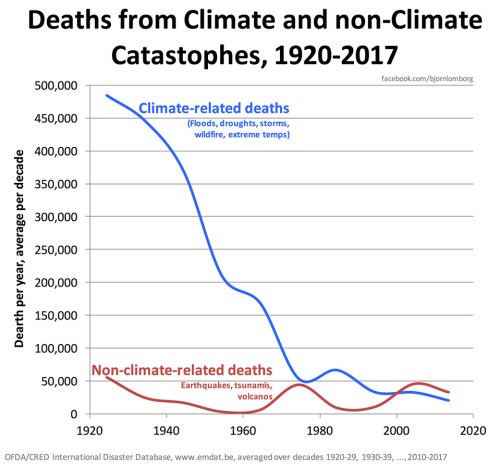 CCD Editor’s Note: In 1920, CO2 levels were 303 PPM or 0.03%. Last year they were 406 PPM or 0.04%. Despite our global population quadrupling, climate deaths have actually gone down as CO2 levels have gone up. Lomborg explains why with the now-standard, often-by-rote “this does not mean that there is no global warming” caveat.
CCD Editor’s Note: In 1920, CO2 levels were 303 PPM or 0.03%. Last year they were 406 PPM or 0.04%. Despite our global population quadrupling, climate deaths have actually gone down as CO2 levels have gone up. Lomborg explains why with the now-standard, often-by-rote “this does not mean that there is no global warming” caveat.
* * * * *
This is clearly opposite of what you normally hear, but that is because we’re often just being told of one disaster after another – telling us how many events are happening. (emphasis added)
The number of reported events is increasing, but that is mainly due to better reporting, lower thresholds, and better accessibility (the CNN effect). For instance, for Denmark, the database only shows events starting from 1976.
Instead, look at the number of dead per year, which is much harder to fudge. Given that these numbers fluctuate enormously from year to year (especially in the past, with huge droughts and floods in China), they are here presented as averages of each decade (1920-29, 1930-39 etc, with last decade as 2010-17).
The data is from the most respected global database, the International Disaster Database. There is some uncertainty about complete reporting from early decades, which is why this graph starts in 1920, and if anything this uncertainty means the graph underestimates the reduction in deaths.
Notice, this does not mean that there is no global warming or that possibly a climate signal could eventually lead to further deaths. Instead, it shows that our increased wealth and adaptive capacity has vastly outdone any negative impact from the climate.
Notice that the reduction in absolute deaths has happened while the global population has increased four-fold. The individual risk of dying from climate-related disasters has declined by 98.9%.
Last year, fewer people died in climate disasters than at any point in the last three decades (1986 was a similarly fortunate year).
Somewhat surprisingly, while climate-related deaths have been declining strongly for 70 years, non-climate deaths have not seen a similar decline, and should probably get more of our attention.
Source: The International Disaster Database
via LinkedIn




















So many legitimate problems receive less coverage and therefore less effort to solve them because the fake problem of climate change gets so much media coverage. Of premature deaths, alcohol use is clearly number one. The World Health Organization estimates, twenty five percent of deaths in people between the ages of nineteen and forty five are alcohol related. Drug over doses are number two and increasing at an alarming rate.
If a heat wave finishes you off, you were near – death anyway.
But heat – waves are just weather, no? “Climate – related death” is a canard. If you die in a snow storm in April, is that a climate related death?
” mainly due to better reporting, lower thresholds, and better accessibility (the CNN effect).”
ITS DUE TO TELEVISION!
But as many of us know radical Eco-Wackos like Dave Foreman wants few humans and the deadlists Hurricane hit Galveston in 1900 and Americas deadlists Tornado was the Tri-State Tornado back in 1920 long before SUV,s and the summer backyard BBQ